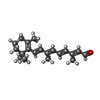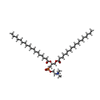+Search query
-Structure paper
| Title | The high-light-sensitivity mechanism and optogenetic properties of the bacteriorhodopsin-like channelrhodopsin GtCCR4. |
|---|---|
| Journal, issue, pages | Mol Cell, Vol. 84, Issue 18, Page 3530-33544.e6, Year 2024 |
| Publish date | Sep 19, 2024 |
 Authors Authors | Tatsuki Tanaka / Shoko Hososhima / Yo Yamashita / Teppei Sugimoto / Toshiki Nakamura / Shunta Shigemura / Wataru Iida / Fumiya K Sano / Kazumasa Oda / Takayuki Uchihashi / Kota Katayama / Yuji Furutani / Satoshi P Tsunoda / Wataru Shihoya / Hideki Kandori / Osamu Nureki /  |
| PubMed Abstract | Channelrhodopsins are microbial light-gated ion channels that can control the firing of neurons in response to light. Among several cation channelrhodopsins identified in Guillardia theta (GtCCRs), ...Channelrhodopsins are microbial light-gated ion channels that can control the firing of neurons in response to light. Among several cation channelrhodopsins identified in Guillardia theta (GtCCRs), GtCCR4 has higher light sensitivity than typical channelrhodopsins. Furthermore, GtCCR4 shows superior properties as an optogenetic tool, such as minimal desensitization. Our structural analyses of GtCCR2 and GtCCR4 revealed that GtCCR4 has an outwardly bent transmembrane helix, resembling the conformation of activated G-protein-coupled receptors. Spectroscopic and electrophysiological comparisons suggested that this helix bend in GtCCR4 omits channel recovery time and contributes to high light sensitivity. An electrophysiological comparison of GtCCR4 and the well-characterized optogenetic tool ChRmine demonstrated that GtCCR4 has superior current continuity and action-potential spike generation with less invasiveness in neurons. We also identified highly active mutants of GtCCR4. These results shed light on the diverse structures and dynamics of microbial rhodopsins and demonstrate the strong optogenetic potential of GtCCR4. |
 External links External links |  Mol Cell / Mol Cell /  PubMed:39232582 PubMed:39232582 |
| Methods | EM (single particle) |
| Resolution | 2.71 - 2.86 Å |
| Structure data | EMDB-39197, PDB-8yej: EMDB-39198, PDB-8yek: EMDB-39199, PDB-8yel: |
| Chemicals |  ChemComp-RET:  ChemComp-HOH:  ChemComp-PC1: |
| Source |
|
 Keywords Keywords | MEMBRANE PROTEIN / Microbial rhodopsin |
 Movie
Movie Controller
Controller Structure viewers
Structure viewers About Yorodumi Papers
About Yorodumi Papers










